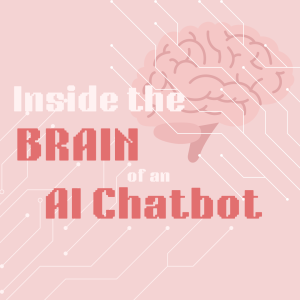Inside the Brain of an AI Chatbot
By Vivienne Couris, C2ST Intern, DePaul University
AI chatbots have taken the world by storm. ChatGPT, Bard, and Copilot are just a few examples of chatbots that are already changing how we work and learn. However, despite their sharp increase in popularity, software like this has been around for quite some time. The natural language processing program ELIZA, which finished development in 1966, is classified as the first AI software. ELIZA could analyze simple conversational inputs and output human-like responses. Computer scientists and engineers have come a long way since then, creating the impressive language models we have access to now. In this blog, we’ll discover the fascinating technology that powers modern AI chatbots.

On a surface level, the AI chatbot is simply a special software designed to take speech input and output a logical response. Some chatbots are rules-based. This means they can only understand certain inputs, and have prepared scripted answers to each phrase they’re programmed to understand. Other bots, like ChatGPT and Bard are AI-powered. This type of bot will be the focus of this blog. AI-powered bots work by utilizing complicated algorithms that can discern massive amounts of data in order to formulate coherent responses to any type of input. They can even ask clarifying questions if the input does not make sense, or has typos. These bots can “think” and continuously learn through a process called machine learning.
Machine learning refers to the incredible ability of an algorithm, a complex problem-solving formula embedded in software, to learn. AI chatbots use machine learning to recognize patterns and predict appropriate responses. They are initially trained to do this by human engineers. ChatGPT, for example, received positive or negative feedback from its creators on its replies, in order to help it “learn” which responses are desirable. Additionally, the massive amounts of data it was initially fed enabled it to understand how language is structured and written. Even though it has already been released, ChatGPT still uses machine learning and user feedback to further its “knowledge” and become more precise. This means that ChatGPT is “smarter” now than it was when it first came out, and this upward trend will continue as the model gets older!
Now, you may be wondering if there are limits to this seemingly never-ending learning. AI language models are certainly not perfect. They have been known to spread misinformation, raise security concerns, and perpetuate social bias. Some worry that the abilities of AI will overcome the need for human workers and lead to the loss of careers. Others are worried about the abilities of chatbots to assist in creating fake news and phishing scams. These are legitimate concerns and have unfortunately happened already. For this reason, we must learn how to regulate AI systems to keep everyone safe.
Overall, AI chatbots and language models of our modern scale are relatively new. Their abilities are undoubtedly amazing, and they are capable of helping people in lots of different areas of their lives. From improving general productivity to analyzing complex data, AI chatbots can provide impressive benefits for everyone. However, it is important to stay cautious and recognize their limitations in order to protect ourselves from certain drawbacks. The next time you find yourself interacting with a chatbot, take a moment to appreciate the amazing engineering that went into its creation!
References
- https://www.ibm.com/topics/machine-learning
- https://www.mathworks.com/discovery/machine-learning.html#:~:text=Tutorials%20and%20examples-,How%20Machine%20Learning%20Works,intrinsic%20structures%20in%20input%20data.
- https://www.ibm.com/blog/chatbot-types/
- https://unstop.com/blog/chat-gpt-and-machine-learning
- https://sitn.hms.harvard.edu/flash/2023/the-making-of-chatgpt-from-data-to-dialogue/#:~:text=The%20initial%20training%20data%20consisted,Reinforcement%20Learning%20with%20Human%20Feedback.
- https://www.technologyreview.com/2023/04/03/1070893/three-ways-ai-chatbots-are-a-security-disaster/
- https://www.citizen.org/article/chatbots-are-not-people-dangerous-human-like-anthropomorphic-ai-report/